Hui Zhou
Native-AI Empowered Scalable Architectures and Solutions for Future Non-Terrestrial Networks: An Overview
Jul 16, 2025Abstract:As the path toward 6G networks is being charted, the emerging applications have motivated evolutions of network architectures to realize the efficient, reliable, and flexible wireless networks. Among the potential architectures, the non-terrestrial network (NTN) and open radio access network (ORAN) have received increasing interest from both academia and industry. Although the deployment of NTNs ensures coverage, enhances spectral efficiency, and improves the resilience of wireless networks. The high altitude and mobility of NTN present new challenges in the development and operations (DevOps) lifecycle, hindering intelligent and scalable network management due to the lack of native artificial intelligence (AI) capability. With the advantages of ORAN in disaggregation, openness, virtualization, and intelligence, several works propose integrating ORAN principles into the NTN, focusing mainly on ORAN deployment options based on transparent and regenerative systems. However, a holistic view of how to effectively combine ORAN and NTN throughout the DevOps lifecycle is still missing, especially regarding how intelligent ORAN addresses the scalability challenges in NTN. Motivated by this, in this paper, we first provide the background knowledge about ORAN and NTN, outline the state-of-the-art research on ORAN for NTNs, and present the DevOps challenges that motivate the adoption of ORAN solutions. We then propose the ORAN-based NTN framework, discussing its features and architectures in detail. These include the discussion about flexible fronthaul split, RAN intelligent controllers (RICs) enhancement for distributed learning, scalable deployment architecture, and multi-domain service management. Finally, the future research directions, including combinations of the ORAN-based NTN framework and other enabling technologies and schemes, as well as the candidate use cases, are highlighted.
A Clinician-Friendly Platform for Ophthalmic Image Analysis Without Technical Barriers
Apr 22, 2025Abstract:Artificial intelligence (AI) shows remarkable potential in medical imaging diagnostics, but current models typically require retraining when deployed across different clinical centers, limiting their widespread adoption. We introduce GlobeReady, a clinician-friendly AI platform that enables ocular disease diagnosis without retraining/fine-tuning or technical expertise. GlobeReady achieves high accuracy across imaging modalities: 93.9-98.5% for an 11-category fundus photo dataset and 87.2-92.7% for a 15-category OCT dataset. Through training-free local feature augmentation, it addresses domain shifts across centers and populations, reaching an average accuracy of 88.9% across five centers in China, 86.3% in Vietnam, and 90.2% in the UK. The built-in confidence-quantifiable diagnostic approach further boosted accuracy to 94.9-99.4% (fundus) and 88.2-96.2% (OCT), while identifying out-of-distribution cases at 86.3% (49 CFP categories) and 90.6% (13 OCT categories). Clinicians from multiple countries rated GlobeReady highly (average 4.6 out of 5) for its usability and clinical relevance. These results demonstrate GlobeReady's robust, scalable diagnostic capability and potential to support ophthalmic care without technical barriers.
Exposing the Copycat Problem of Imitation-based Planner: A Novel Closed-Loop Simulator, Causal Benchmark and Joint IL-RL Baseline
Apr 20, 2025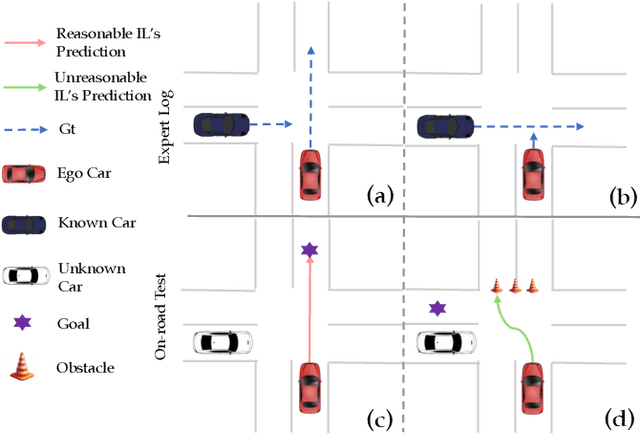
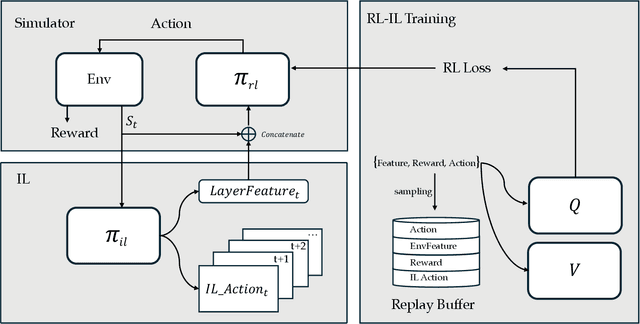

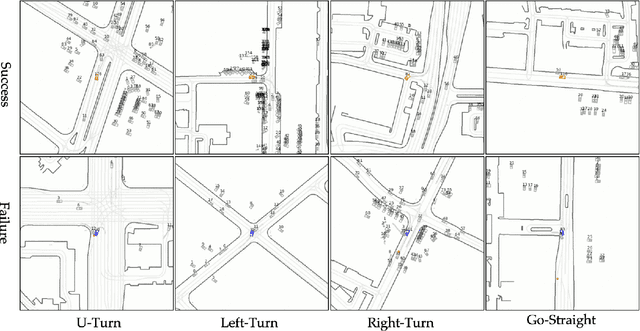
Abstract:Machine learning (ML)-based planners have recently gained significant attention. They offer advantages over traditional optimization-based planning algorithms. These advantages include fewer manually selected parameters and faster development. Within ML-based planning, imitation learning (IL) is a common algorithm. It primarily learns driving policies directly from supervised trajectory data. While IL has demonstrated strong performance on many open-loop benchmarks, it remains challenging to determine if the learned policy truly understands fundamental driving principles, rather than simply extrapolating from the ego-vehicle's initial state. Several studies have identified this limitation and proposed algorithms to address it. However, these methods often use original datasets for evaluation. In these datasets, future trajectories are heavily dependent on initial conditions. Furthermore, IL often overfits to the most common scenarios. It struggles to generalize to rare or unseen situations. To address these challenges, this work proposes: 1) a novel closed-loop simulator supporting both imitation and reinforcement learning, 2) a causal benchmark derived from the Waymo Open Dataset to rigorously assess the impact of the copycat problem, and 3) a novel framework integrating imitation learning and reinforcement learning to overcome the limitations of purely imitative approaches. The code for this work will be released soon.
Breaking Through the Spike: Spike Window Decoding for Accelerated and Precise Automatic Speech Recognition
Jan 01, 2025



Abstract:Recently, end-to-end automatic speech recognition has become the mainstream approach in both industry and academia. To optimize system performance in specific scenarios, the Weighted Finite-State Transducer (WFST) is extensively used to integrate acoustic and language models, leveraging its capacity to implicitly fuse language models within static graphs, thereby ensuring robust recognition while also facilitating rapid error correction. However, WFST necessitates a frame-by-frame search of CTC posterior probabilities through autoregression, which significantly hampers inference speed. In this work, we thoroughly investigate the spike property of CTC outputs and further propose the conjecture that adjacent frames to non-blank spikes carry semantic information beneficial to the model. Building on this, we propose the Spike Window Decoding algorithm, which greatly improves the inference speed by making the number of frames decoded in WFST linearly related to the number of spiking frames in the CTC output, while guaranteeing the recognition performance. Our method achieves SOTA recognition accuracy with significantly accelerates decoding speed, proven across both AISHELL-1 and large-scale In-House datasets, establishing a pioneering approach for integrating CTC output with WFST.
A General Sensing-assisted Channel Estimation Framework in Distributed MIMO Network
Nov 24, 2024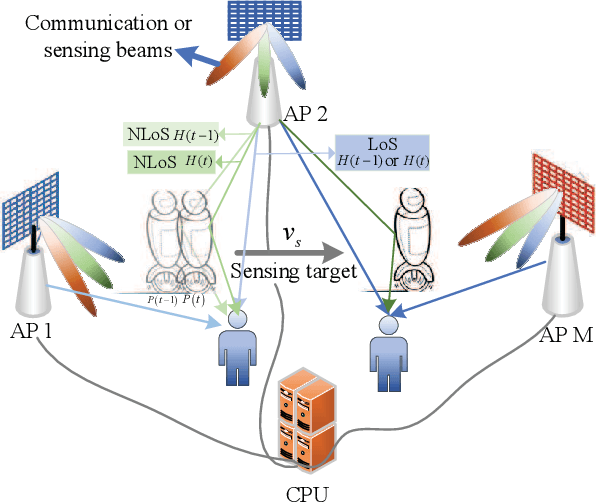
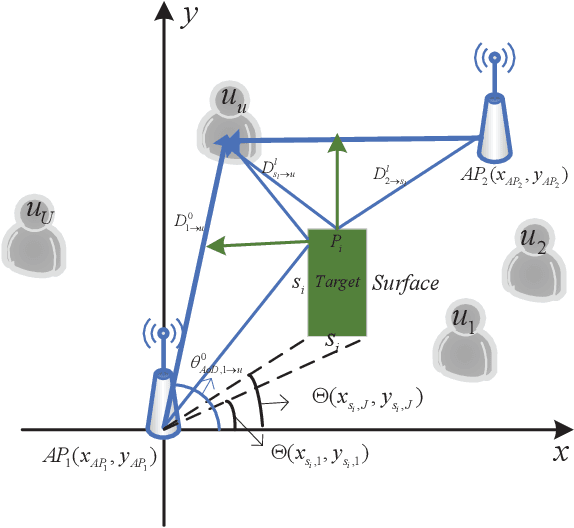
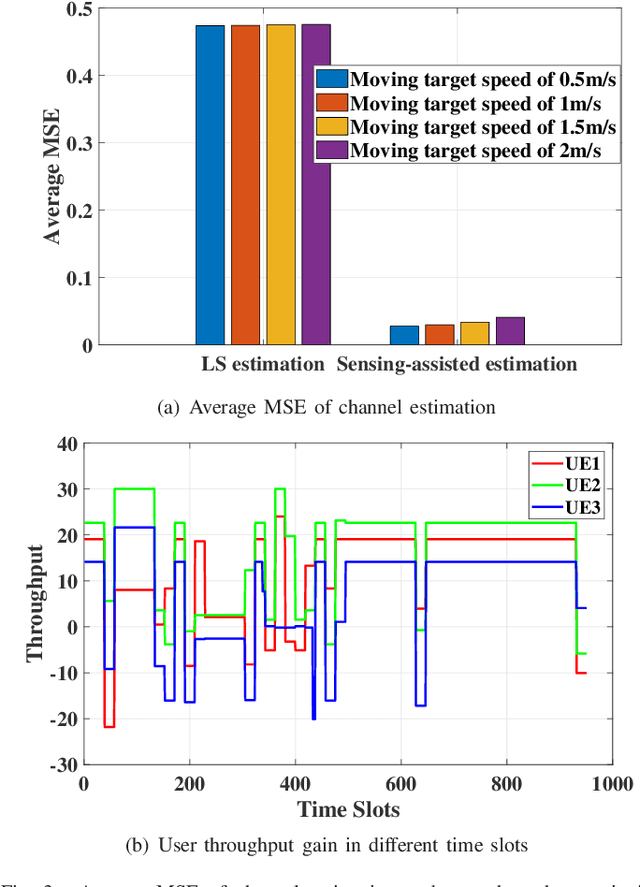
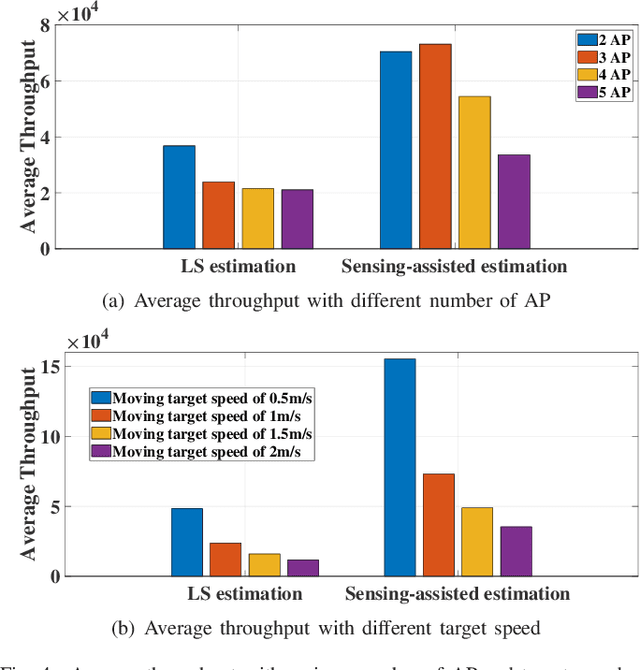
Abstract:Joint sensing and communication (JSC) research direction has been envisioned to be a key technology in 6G communications, which has the potential to equip the traditional base station with sensing capability by fully exploiting the existing wireless communication infrastructures. To further enhance wireless communication performance in JSC, sensing-assisted communication has attracted attention from both industry and academia. However, most existing papers focused on sensing-assisted communication under line-of-sight (LoS) scenarios due to sensing limitations, where the sensing target and communication user remain the same. In this paper, we propose a general sensing-assisted channel estimation framework, where the channel estimation accuracy for both Los and non-line-of-sight (NLoS) are considered. Simulation results demonstrate that our proposed sensing-assisted communication framework achieves higher channel estimation accuracy and throughput compared to the traditional least-square (LS) estimation. More importantly, the feasibility of the proposed framework has been validated to solve the complex channel estimation challenge in distributed multiple input and multiple output (MIMO) network.
Deploying Multi-task Online Server with Large Language Model
Nov 07, 2024
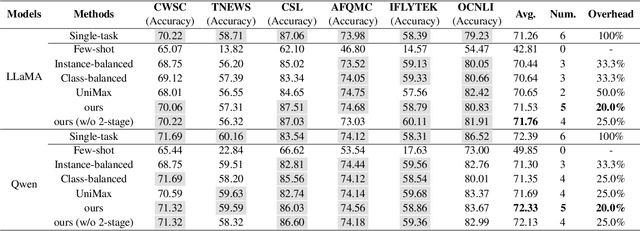
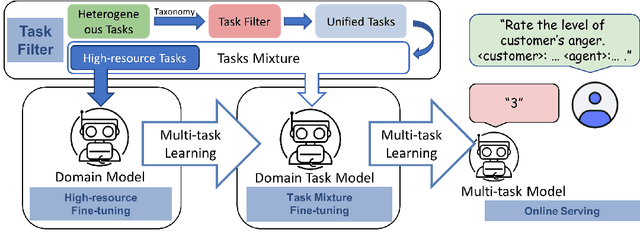

Abstract:In the industry, numerous tasks are deployed online. Traditional approaches often tackle each task separately by its own network, which leads to excessive costs for developing and scaling models, especially in the context of large language models. Although multi-task methods can save costs through parameter sharing, they often struggle to outperform single-task methods in real-world applications. To tackle these challenges, we present a three-stage multi-task learning framework for large language models. It involves task filtering, followed by fine-tuning on high-resource tasks, and finally fine-tuning on all tasks. We conducted comprehensive experiments in single-task and multi-task settings. Our approach, exemplified on different benchmarks, demonstrates that it is able to achieve performance comparable to the single-task method while reducing up to 90.9\% of its overhead.
Towards Reflected Object Detection: A Benchmark
Jul 08, 2024



Abstract:Object detection has greatly improved over the past decade thanks to advances in deep learning and large-scale datasets. However, detecting objects reflected in surfaces remains an underexplored area. Reflective surfaces are ubiquitous in daily life, appearing in homes, offices, public spaces, and natural environments. Accurate detection and interpretation of reflected objects are essential for various applications. This paper addresses this gap by introducing a extensive benchmark specifically designed for Reflected Object Detection. Our Reflected Object Detection Dataset (RODD) features a diverse collection of images showcasing reflected objects in various contexts, providing standard annotations for both real and reflected objects. This distinguishes it from traditional object detection benchmarks. RODD encompasses 10 categories and includes 21,059 images of real and reflected objects across different backgrounds, complete with standard bounding box annotations and the classification of objects as real or reflected. Additionally, we present baseline results by adapting five state-of-the-art object detection models to address this challenging task. Experimental results underscore the limitations of existing methods when applied to reflected object detection, highlighting the need for specialized approaches. By releasing RODD, we aim to support and advance future research on detecting reflected objects. Dataset and code are available at: https: //github.com/Tqybu-hans/RODD.
YOLO-MED : Multi-Task Interaction Network for Biomedical Images
Mar 01, 2024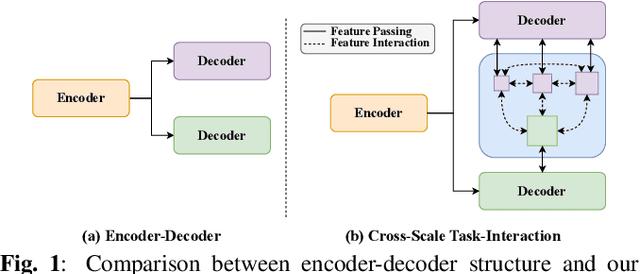
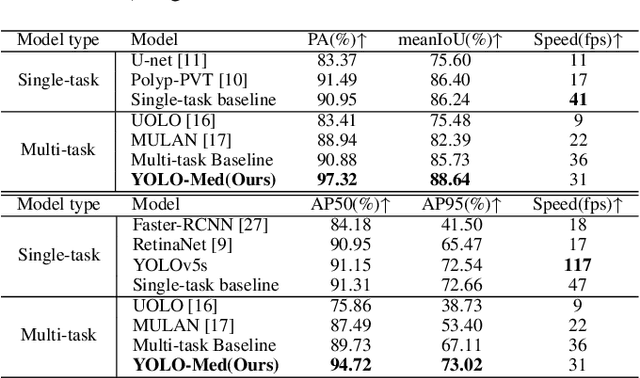
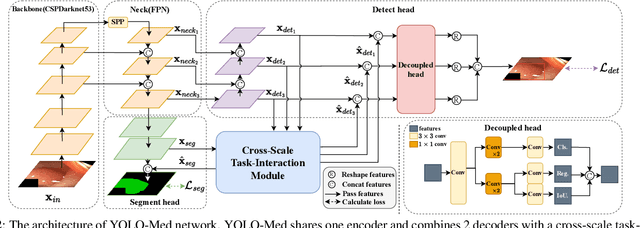

Abstract:Object detection and semantic segmentation are pivotal components in biomedical image analysis. Current single-task networks exhibit promising outcomes in both detection and segmentation tasks. Multi-task networks have gained prominence due to their capability to simultaneously tackle segmentation and detection tasks, while also accelerating the segmentation inference. Nevertheless, recent multi-task networks confront distinct limitations such as the difficulty in striking a balance between accuracy and inference speed. Additionally, they often overlook the integration of cross-scale features, which is especially important for biomedical image analysis. In this study, we propose an efficient end-to-end multi-task network capable of concurrently performing object detection and semantic segmentation called YOLO-Med. Our model employs a backbone and a neck for multi-scale feature extraction, complemented by the inclusion of two task-specific decoders. A cross-scale task-interaction module is employed in order to facilitate information fusion between various tasks. Our model exhibits promising results in balancing accuracy and speed when evaluated on the Kvasir-seg dataset and a private biomedical image dataset.
BDEC:Brain Deep Embedded Clustering model
Sep 12, 2023Abstract:An essential premise for neuroscience brain network analysis is the successful segmentation of the cerebral cortex into functionally homogeneous regions. Resting-state functional magnetic resonance imaging (rs-fMRI), capturing the spontaneous activities of the brain, provides the potential for cortical parcellation. Previous parcellation methods can be roughly categorized into three groups, mainly employing either local gradient, global similarity, or a combination of both. The traditional clustering algorithms, such as "K-means" and "Spectral clustering" may affect the reproducibility or the biological interpretation of parcellations; The region growing-based methods influence the expression of functional homogeneity in the brain at a large scale; The parcellation method based on probabilistic graph models inevitably introduce model assumption biases. In this work, we develop an assumption-free model called as BDEC, which leverages the robust data fitting capability of deep learning. To the best of our knowledge, this is the first study that uses deep learning algorithm for rs-fMRI-based parcellation. By comparing with nine commonly used brain parcellation methods, the BDEC model demonstrates significantly superior performance in various functional homogeneity indicators. Furthermore, it exhibits favorable results in terms of validity, network analysis, task homogeneity, and generalization capability. These results suggest that the BDEC parcellation captures the functional characteristics of the brain and holds promise for future voxel-wise brain network analysis in the dimensionality reduction of fMRI data.
ContrastMotion: Self-supervised Scene Motion Learning for Large-Scale LiDAR Point Clouds
Apr 25, 2023



Abstract:In this paper, we propose a novel self-supervised motion estimator for LiDAR-based autonomous driving via BEV representation. Different from usually adopted self-supervised strategies for data-level structure consistency, we predict scene motion via feature-level consistency between pillars in consecutive frames, which can eliminate the effect caused by noise points and view-changing point clouds in dynamic scenes. Specifically, we propose \textit{Soft Discriminative Loss} that provides the network with more pseudo-supervised signals to learn discriminative and robust features in a contrastive learning manner. We also propose \textit{Gated Multi-frame Fusion} block that learns valid compensation between point cloud frames automatically to enhance feature extraction. Finally, \textit{pillar association} is proposed to predict pillar correspondence probabilities based on feature distance, and whereby further predicts scene motion. Extensive experiments show the effectiveness and superiority of our \textbf{ContrastMotion} on both scene flow and motion prediction tasks. The code is available soon.
 Add to Chrome
Add to Chrome Add to Firefox
Add to Firefox Add to Edge
Add to Edge